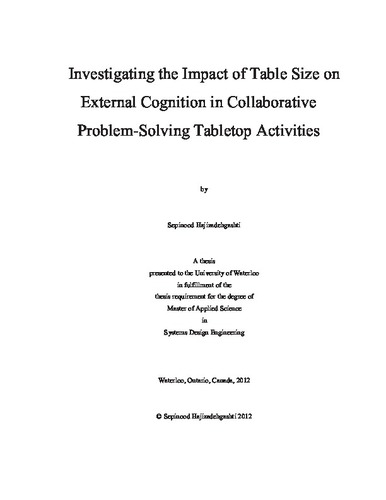UWSpace will be migrating to a new version of its software from July 29th to August 1st. UWSpace will be offline for all UW community members during this time.
Investigating the Impact of Table Size on External Cognition in Collaborative Problem-Solving Tabletop Activities
| dc.contributor.author | Hajizadehgashti, Sepinood | |
| dc.date.accessioned | 2012-08-31 13:56:26 (GMT) | |
| dc.date.available | 2012-08-31 13:56:26 (GMT) | |
| dc.date.issued | 2012-08-31T13:56:26Z | |
| dc.date.submitted | 2012-08-23 | |
| dc.identifier.uri | http://hdl.handle.net/10012/6951 | |
| dc.description.abstract | Tables have been used for working and studying for years, and people continue using tables to work with digital artifacts. Collaborative tabletop activities such as planning, designing, and scheduling are common on traditional tables, but digital tables still face a variety of design issues to facilitate doing the same tasks. For example, due to the high cost of digital tables, it is unclear how large a digital table must be to support collaborative problem solving. This thesis examines the impact of physical features, in particular the table size, on collaborative tasks. This research leverages findings of previous studies of traditional and digital tables, and focuses on exploring the interaction of table size and users’ seating arrangement in collaborative problem solving. An experimental study is used to observe the behaviors of two-member groups while doing problem-solving tasks. Two tasks, storytelling and travel planning, were selected for this study, and the experiments were performed on two traditional tables, one small and one large. Although working on digital and traditional tables differs, investigating the impact of physical features in traditional tables can help us better understand how these features interact with workspace awareness and external cognition factors during taskwork. In the empirical study, external cognitive behaviors of participants were deeply analyzed to understand how physical settings of the table and seating arrangement affect the way people manipulate artifacts in the table workspace. Collaborators passed through different stages of problem solving using varied strategies, and the data analysis revealed that they manipulated material on the tabletop for understanding, organizing and solution making through visual separation, cognitive tracing and piling. Table size, task type and user seating arrangement showed strong effects on the external cognition of collaborators. In particular, the accessibility of sufficient space on the table influenced how much users could distribute their materials to improve workspace awareness and cognitive tracing. On the other hand, lack of space or inaccessible space forced people to use the space above the table—by holding materials in their hands—or to pile materials to compensate for space limitations. The insights gained from this research inform design decisions regarding size and seating arrangement for tabletop workspaces. For cases in which there is insufficient space, design alternatives are recommended to improve accessibility to artifacts to compensate for space limitations. These solutions aim to enhance the external cognition of users when space is insufficient to work with artifacts in problem-solving tasks. | en |
| dc.language.iso | en | en |
| dc.publisher | University of Waterloo | en |
| dc.subject | External cognition | en |
| dc.subject | Cognitive tracing | en |
| dc.subject | Tabletop activities | en |
| dc.subject | Collaborative problem solving | en |
| dc.title | Investigating the Impact of Table Size on External Cognition in Collaborative Problem-Solving Tabletop Activities | en |
| dc.type | Master Thesis | en |
| dc.pending | false | en |
| dc.subject.program | System Design Engineering | en |
| uws-etd.degree.department | Systems Design Engineering | en |
| uws-etd.degree | Master of Applied Science | en |
| uws.typeOfResource | Text | en |
| uws.peerReviewStatus | Unreviewed | en |
| uws.scholarLevel | Graduate | en |

